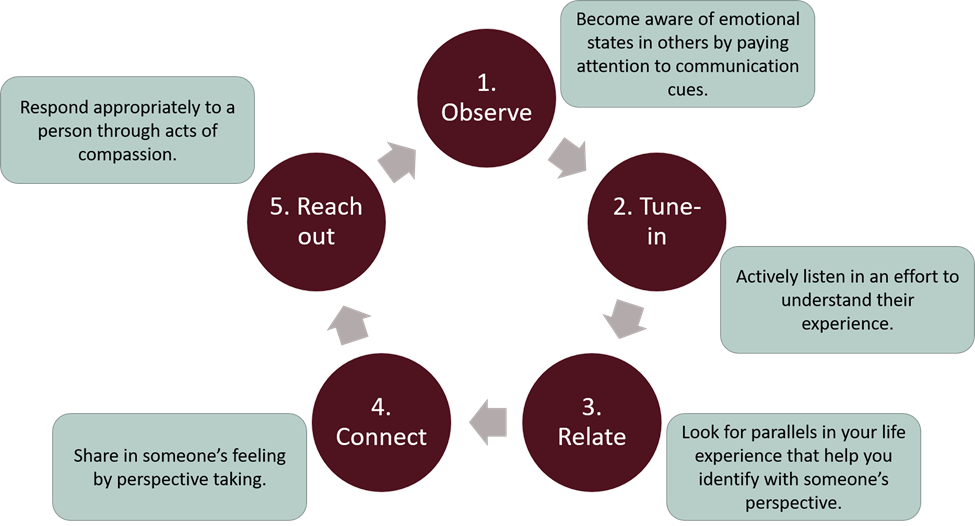9 Emotional Intelligence
Emotional Intelligence and Self-Management
Feelings matter at work! Emotional intelligence, also known as EI or EQ for emotional quotient, is the ability to recognize, understand, and manage your own emotions. You have your own characteristics, personality, wants, and needs. It takes time and reflection to understand how those parts of yourself feed into your emotions. Once you start to know yourself, you can start to interpret how your emotions affect the people around you and how they effect your perceptions of others.
What can emotional intelligence look like? As a child, you demonstrated early signs of emotional intelligence every time you gave another child a turn on the playground swing or slide, kept your cool when your turn was taken, or asked to have a turn. As a WIL student at work, it might look like taking responsibility for your actions when you make a mistake, pulling your weight on group tasks and priorities, and helping to resolve conflicts. In class, it might look like sharing notes with a classmate, offering personal reflection during class discussion, and engaging productively in group work.
Watch the following video for an introduction to emotional intelligence. (7.29 min)
Use Goleman’s Emotional Intelligence Framework
Goleman’s Emotional Intelligence framework (1998) can help you understand emotional intelligence and guide your composure and decisions. The five components are self-awareness, self-regulation, motivation, empathy, and relationship management (Goleman, 1998, p.24). Take a look at this framework and reflect on which competencies you have and which competencies you need to build.
Goleman’s emotional intelligence framework includes the following five components and competencies:
Use the left and right arrows in this interactive activity to explore the framework.
Strategies for Emotional Intelligence
Emotional intelligence is the ability to pay attention to and evaluate your emotions and the emotions of others and groups. Emotional intelligence evolves and shifts depending on our situations over our lifetime and is something that you can work on everyday in all aspects of your life. To help you start on this journey, here are some useful steps you can take to build your emotional intelligence in your academics and within the workplace.
Self Awareness
Self-awareness brings together three different parts of yourself: emotional awareness, self-assessment, and self-confidence. It is about connecting how you feel with how you act. It is also about how assertive and comfortable you are with making decisions and stating your preferences. Much of this work you will need to do on your own, as it is reflective in nature. Take time to do it on break, on the way to work, or at the end of the day.
- Check in with your emotions. Try to use clear descriptions to clarify how you are feeling (even if you just do it in your own head). See if you can connect how you feel to how well you engaged and participated. You can also think about how productive you were and how attentive you were during your work time.
- Reflect on your strengths and weaknesses. You can do this on your own or get help from someone with more experience in the field. Ask an instructor or supervisor for feedback. When you receive feedback, try to explain it in your own words. Ask questions if you aren’t sure.
- Take opportunities to speak publicly. Whether it is in the safety of a classroom discussion or in a department meeting, practice voicing your opinion. Work on your body language, your non-verbal gestures, and your tone of voice. If you want private practice, record yourself and analyze the results.
Self-Regulation
Self-regulation is all about consistency. It is about building up confidence over time, and continuing to be reliable, even when things don’t go your way. Trustworthiness comes from honesty, ethics, timeliness, and organization. Conscientiousness comes when you increase your ability to work independently without direction. Innovation and adaptability are linked to creativity and, of course, your ability to handle (and even embrace!) change.
- Be honest when you do something wrong. Own up to your mistakes quickly and efficiently. At school, this may mean apologizing if you fall behind with coursework or asking for a makeup test. At work, this may mean explaining to your supervisor when you make a mistake and then describing your plan to fix it.
- Stick with a task, even when it is hard. Work isn’t always easy. It may be draining to tackle certain projects, but getting your work done on time will help your co-workers, peers, and employers rely on you.
- Focus on time management. Make those to do lists, organize your calendar, and meet all of your obligations.
Self Efficacy
Self-efficacy is your belief in yourself and the way you advocate for you and your needs. The perception that you have of yourself is important in your professional and personal growth. If you view yourself in a negative light, then likely your outward thoughts and actions will match. When you view yourself in a positive light, you create self-efficacy, positive thinking, and find the good in people and situations. Self-efficacy goes beyond just your skills and leans to your belief in yourself and what you can do with the skills that you have (Goleman, 1998). Simply having skills or knowing the competencies in this chapter is not enough. You must believe in your abilities to perform the skills in order to use them optimally (Goleman, 1998). Part of practicing self-efficacy is learning to communicate your emotions effectively. You know that you are advocating for yourself appropriately when you are able to speak your mind while continuing to create and maintain positive relationships.
Motivation
When it comes to emotional intelligence, motivation is more about your attitude and how you are perceived. Do your coworkers, peers, instructors, and supervisors see you as motivated?
- Look for opportunities to grow. Encourage and embrace feedback. Learn from your mistakes. Take on new challenges and learn as you go. Taking initiative and then following through on it will catch the eye of your supervisor or instructor.
- Show your commitment and loyalty. Don’t be afraid of being too excited about your job or school. If you have passion, let it show. When you start working somewhere new, learn about the goals and purpose of the organization, and keep those in mind when you are working.
- Be optimistic. Positivity will help you make it through tough times. It will help you when you are stressed or overwhelmed. Hoping for the best while remaining realistic about your situation will help you recover and move forward.
Empathy
Empathy is how we connect to the feelings of others. It is how you imagine you would feel from someone else’s point of view. In essence, it is a way of trying to feel how others feel, and then reflecting on that experience. Remember that all people have things going on in their lives outside of the contexts in which you see them. At school and work, empathy can help you connect with others and better understand their challenges.
- Acknowledge other people’s feelings and experiences. Empathize if someone who is having a tough time. Give people space to share their feelings. Practice active listening and try to paraphrase what they are saying.
- Celebrate the successes of others. We often focus on the negative and neglect the positive. If someone did well on their last test, had a great interview, or got a promotion, congratulate them. Validation builds trust and connection, and, it’s fun!
- Identify the needs of your clients. If you work in customer or client service, really focus on their experience. If you can, notice challenges or problems that make it harder for them to get what they need. If it is in your power, make changes or suggestions to your employer to see if you can make things better.
- Engage in cultural competency and humility. We all have biases and bring those with us to our jobs. Learn more about other cultures and experiences.
Watch this video with Brené Brown to hear the difference in between empathy and sympathy: Brené Brown on Empathy vs Sympathy. (2.59 mins)

Image Descriptions
- Observe. Become aware of emotional States in others by paying attention to communication cues.
- Tune-in. Actively listen in an effort to understand their experience.
- Relate. Look for parallels in your life experience that help you identify with someone’s perspective.
- Connect. Share in someone’s feeling by taking perspective.
- Reach out. Respond appropriately to a person through acts of compassion.
Media Attributions
- “Emotional Intelligence by Daniel Goleman ► Animated Book Summary” by One Percent Better is licensed under a Standard YouTube License.
- “Brené Brown on Empathy vs Sympathy” by Diana Simon Psihoterapeut is licensed under a Standard YouTube License.
- “The Empathy Wheel” by Deb Nielsen, Emily Ballantyne, Fatimah Murad and Melissa Fournier, adapted from The Empathy Training Project, n.d., is licensed under a CC BY-NC 4.0 licence.
References
Goleman, D. (1998). Working with emotional intelligence. Bantam Books.

